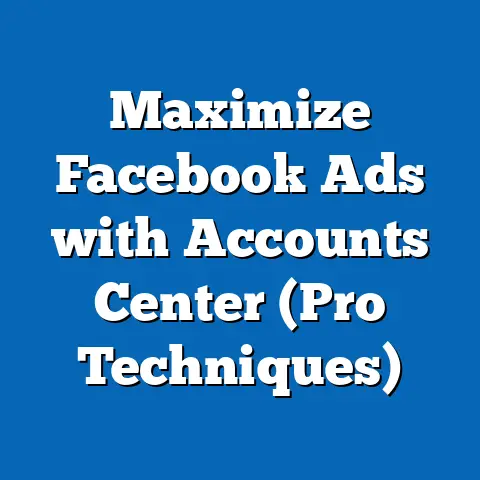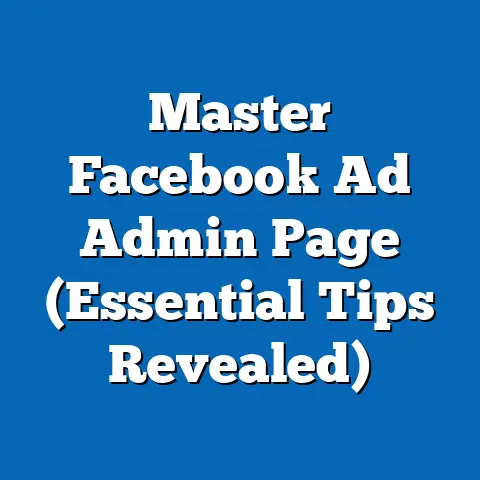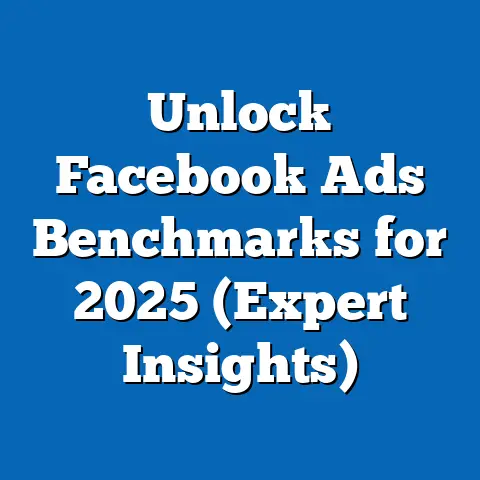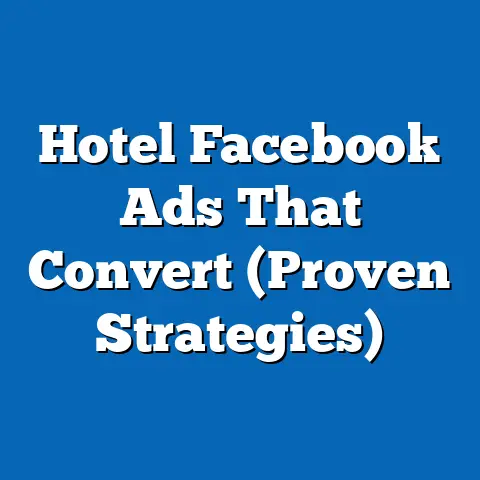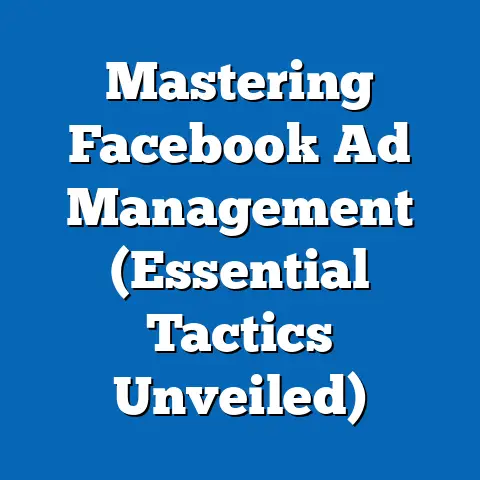Unlock Facebook Ad Account Limits (Proven Strategies Inside)
Have you ever felt like you’re running a marathon with a ball and chain? That’s how it feels when you’re trying to scale your Facebook ads, only to be slammed with an ad account restriction. It’s frustrating, disheartening, and can seriously impact your bottom line. Did you know that a significant percentage of Facebook advertisers – I’ve seen estimates as high as 30% – have experienced sudden account restrictions that cripple their campaigns? I remember one time, back in 2018, when a client of mine, a burgeoning e-commerce store, was about to launch their biggest product campaign yet. They had the creative, the targeting, and the budget locked and loaded. Then, bam! Account restriction. It nearly derailed their entire launch, costing them thousands in lost revenue.
The sting of that experience, and many others like it, fueled my determination to understand why these restrictions happen and, more importantly, how to overcome them.
The truth is, Facebook ad account limits are a necessary evil. They’re there to protect users, maintain platform integrity, and prevent malicious actors from wreaking havoc. But for legitimate businesses trying to grow, these limits can feel like a constant obstacle. That’s why understanding how to navigate and ultimately unlock those limits is crucial for maximizing your ad performance and revenue.
In this article, I’m going to pull back the curtain and share the proven strategies I’ve learned over years of managing Facebook ad accounts, helping businesses large and small navigate these tricky waters. I’ll walk you through understanding the different types of limits, the common causes for restrictions, and most importantly, the actionable steps you can take to unlock your account and get back to scaling your campaigns. Get ready to take control of your advertising success on Facebook!
Understanding Facebook Ad Account Limits
Let’s start with the basics. What exactly are Facebook ad account limits, and why do they even exist?
Simply put, Facebook ad account limits are restrictions placed on your advertising activities within the Facebook Ads Manager. These limits can manifest in various forms, such as:
- Spending Limits: A cap on the total amount you can spend daily or over the lifetime of your campaigns.
- Ad Account Creation Limits: Restrictions on the number of ad accounts you can create within your Business Manager.
- Ad Approval Limits: Limitations on the number of ads you can submit for review within a specific timeframe.
- Campaign Limits: Restrictions on the number of campaigns that can be active at any point in time.
These limits aren’t arbitrary. They’re in place for several reasons:
- Preventing Fraud and Abuse: Facebook uses limits to deter malicious actors from running fraudulent ads, spreading misinformation, or engaging in other harmful activities.
- Maintaining Platform Integrity: By controlling the flow of ads, Facebook aims to ensure a positive user experience and prevent the platform from being overwhelmed with low-quality or irrelevant content.
- Protecting Users: Limits help safeguard users from deceptive or misleading ads, ensuring they receive accurate information and aren’t exposed to harmful products or services.
- Managing Server Load: Facebook’s infrastructure has to handle a massive volume of advertising, and limits help to distribute the load more evenly.
- Encouraging Good Advertising Practices: Accounts that follow Facebook’s policies and consistently produce high-quality ads are more likely to see their limits increased over time.
The Different Types of Limits in Detail
Let’s delve deeper into the specific types of limits you might encounter:
- Spending Limits: This is the most common type of limit and can be particularly frustrating. It restricts the amount you can spend daily or over the lifetime of a campaign. New ad accounts often start with lower spending limits, which gradually increase as you build a positive track record. I’ve seen accounts start as low as \$50/day, which can be incredibly limiting if you’re trying to run a large-scale campaign. The rationale is to prevent significant financial losses if an account is compromised or used for fraudulent purposes.
- Ad Account Creation Limits: Facebook limits the number of ad accounts you can create within your Business Manager. This is to prevent the creation of multiple accounts for circumventing policies or masking fraudulent activity. New Business Managers typically have a very low limit, sometimes just one or two ad accounts.
- Ad Approval Limits: This limit restricts the number of ads you can submit for review within a specific timeframe, usually a day. It’s designed to prevent spamming the system with numerous ads, especially if they are of low quality or potentially violate policies.
- Campaign Limits: Similar to ad approval limits, this restricts the number of campaigns you can have active at any given time. This is designed to prevent users from creating large numbers of campaigns with low-quality ads in each.
Implications of Ad Account Limits on Your Campaigns
The implications of these limits can be significant, especially for businesses with ambitious growth plans.
- Revenue Loss: Spending limits can directly impact your ability to reach your target audience and generate sales. If you’re capped at a low daily budget, you might miss out on valuable opportunities to drive conversions. Remember my client with the product launch? Their spending limit meant they couldn’t reach as many potential customers as they needed to, resulting in a significant drop in projected sales.
- Decreased Visibility: Limits on ad account creation can hinder your ability to test different strategies and target diverse audiences. If you can only create a limited number of ad accounts, you’re forced to consolidate your campaigns, potentially sacrificing granularity and precision.
- Slower Scaling: Building a strong account history takes time, and low initial limits can slow down your ability to scale your campaigns effectively. You might be forced to start with small budgets and gradually increase them, which can be a frustrating process, especially if you’re eager to see rapid growth.
- Missed Opportunities: Ad approval limits can prevent you from quickly testing new ad creatives or responding to market trends. If you’re constantly waiting for ads to be approved, you might miss out on time-sensitive opportunities to capitalize on trending topics or seasonal events.
Real-World Scenarios: When Limits Hit Hard
Let me share a few more real-world scenarios to illustrate the impact of ad account limits:
- The E-commerce Startup: A new e-commerce startup was eager to launch their first Facebook ad campaign. However, their ad account was immediately restricted with a low spending limit due to a perceived risk based on their new business status. This limited their ability to reach their target audience and generate initial sales, making it difficult to gain traction.
- The Lead Generation Agency: A lead generation agency was running multiple campaigns for different clients. Suddenly, one of their ad accounts was flagged for suspicious activity, resulting in a temporary suspension. This disrupted their lead flow and negatively impacted their client relationships.
- The App Developer: An app developer was trying to promote their new mobile app. However, their ads were repeatedly disapproved due to policy violations related to data privacy. This made it difficult for them to reach potential users and drive app downloads.
Key Takeaway: Understanding the different types of Facebook ad account limits and their implications is the first step towards overcoming them. Knowing what you’re up against will help you proactively address potential issues and develop strategies to unlock your account and scale your campaigns effectively.
Common Causes for Account Restrictions
Now that we understand what ad account limits are, let’s explore the common reasons why Facebook imposes these restrictions. Understanding the “why” is crucial for preventing issues in the first place.
Facebook’s algorithm is constantly monitoring ad accounts for various factors that could indicate policy violations, suspicious activity, or other potential problems. Here are some of the top reasons why your account might face restrictions:
- Policy Violations: This is the most common reason for ad account restrictions. Facebook has a comprehensive set of Ad Policies that govern the types of content allowed on the platform. Violating these policies, even unintentionally, can lead to warnings, ad disapprovals, or even account suspensions.
- Payment Issues: Problems with your payment method, such as expired credit cards, insufficient funds, or billing discrepancies, can trigger account restrictions. Facebook needs to ensure that they can collect payment for your ads, so any payment-related issues will raise red flags.
- Suspicious Activity: Unusual activity on your account, such as a sudden spike in ad spending, changes in targeting, or login attempts from unfamiliar locations, can be flagged as suspicious and trigger restrictions. Facebook is constantly on the lookout for compromised accounts and fraudulent activity.
- Low-Quality Ads: Ads that are poorly designed, contain misleading information, or provide a negative user experience can be penalized. Facebook prioritizes user experience, so they’ll take action against ads that are deemed disruptive or irrelevant.
- Negative Feedback: If your ads receive a high number of negative feedback signals, such as users hiding or reporting your ads, Facebook may restrict your account. Negative feedback indicates that your ads are not resonating with your target audience and may be violating policies.
- Circumventing Systems: Any attempt to circumvent Facebook’s ad review process or other systems can lead to immediate account suspension. This includes using cloaking techniques, creating multiple accounts to bypass restrictions, or engaging in other deceptive practices.
Examples of Common Causes and Real-World Cases
Let’s look at some specific examples of how these causes can manifest in real-world scenarios:
- Policy Violation: Promoting Weight Loss Products: A health and wellness company ran ads promoting rapid weight loss using a product that contained unsubstantiated ingredients. This violated Facebook’s policy against promoting unrealistic or dangerous health claims, resulting in ad disapprovals and eventual account restriction.
- Payment Issue: Expired Credit Card: A small business owner forgot to update their credit card information in their ad account. When Facebook attempted to charge for their ads, the payment failed, triggering a temporary account suspension.
- Suspicious Activity: Sudden Spike in Ad Spending: An e-commerce store experienced a sudden surge in sales during a flash sale. They drastically increased their ad spending to capitalize on the opportunity. However, this unusual activity was flagged as suspicious, leading to a temporary account review and spending limit.
- Low-Quality Ads: Misleading Product Claims: A dropshipping store ran ads promoting a product with exaggerated claims that were not supported by evidence. Users reported the ads as misleading, resulting in a negative feedback score and account restriction.
- Circumventing Systems: Using Cloaking Techniques: A marketing agency used cloaking techniques to show different content to Facebook’s ad review team than what was displayed to users. This violated Facebook’s policy against deceptive practices, leading to immediate account suspension.
The Role of Facebook’s Algorithm
It’s important to understand that Facebook’s algorithm plays a significant role in monitoring ad accounts and enforcing its policies. The algorithm uses a variety of signals to identify potential violations and suspicious activity. These signals can include:
- Ad Content Analysis: The algorithm analyzes the text, images, and videos in your ads to identify potential policy violations.
- Landing Page Analysis: The algorithm also analyzes the content on your landing pages to ensure that it aligns with your ad claims and complies with Facebook’s policies.
- User Feedback: The algorithm tracks user feedback signals, such as likes, comments, shares, and reports, to assess the quality and relevance of your ads.
- Account Activity: The algorithm monitors your account activity for unusual patterns, such as sudden changes in spending or targeting.
- Network Analysis: The algorithm analyzes the connections between different ad accounts and businesses to identify potential networks of fraudulent activity.
The Importance of Understanding Facebook’s Ad Policies
Ignorance of Facebook’s Ad Policies is not an excuse. It’s your responsibility as an advertiser to understand and comply with these policies. Failing to do so can have serious consequences, including account restrictions, ad disapprovals, and even permanent account suspension.
Facebook’s Ad Policies are comprehensive and cover a wide range of topics, including:
- Prohibited Content: This includes content that is illegal, discriminatory, or harmful.
- Restricted Content: This includes content that is sensitive or requires special authorization, such as political ads or ads promoting alcohol.
- Personal Attributes: You cannot target users based on personal attributes such as race, ethnicity, religion, or sexual orientation.
- Misleading or Deceptive Practices: You cannot use misleading or deceptive tactics to promote your products or services.
- Data Privacy: You must comply with all applicable data privacy laws and regulations.
Key Takeaway: Understanding the common causes of account restrictions and Facebook’s Ad Policies is crucial for preventing issues and maintaining a healthy ad account. By proactively addressing potential problems and staying informed about policy updates, you can minimize the risk of facing restrictions and keep your campaigns running smoothly.
Proven Strategies to Unlock Your Facebook Ad Account Limits
Okay, so you understand the limits and the reasons behind them. Now, let’s get to the good stuff: the proven strategies you can use to unlock your Facebook ad account limits and get back to scaling your campaigns. I’ve personally used these strategies to help countless businesses overcome restrictions and achieve their advertising goals.
Strategy 1: Optimize Ad Content for Approval
This is the most fundamental strategy, and it starts with creating ads that are not only engaging and persuasive but also fully compliant with Facebook’s Ad Policies. Think of it as building a strong foundation for your advertising efforts.
- Understand the Policies: I can’t stress this enough: Read and understand Facebook’s Ad Policies thoroughly. Don’t just skim them; really dig in and make sure you understand the nuances. Pay particular attention to the sections on prohibited content, restricted content, and misleading or deceptive practices.
- Craft Clear and Accurate Copy: Your ad copy should be clear, concise, and accurate. Avoid making exaggerated claims or using misleading language. Be transparent about what you’re offering and what users can expect.
- Use High-Quality Visuals: Your visuals should be relevant to your ad copy and accurately represent your product or service. Avoid using images or videos that are sexually suggestive, violent, or otherwise offensive.
- Be Mindful of Targeting: Be careful when targeting your ads based on sensitive categories, such as age, gender, or interests. Avoid using these categories in a way that could be perceived as discriminatory or exploitative.
- Review Your Landing Pages: Your landing pages should be consistent with your ad copy and provide a positive user experience. Make sure your landing pages are mobile-friendly, load quickly, and contain accurate information.
- Test Your Ads: Before launching your ads, test them with a small audience to see how they perform. Pay attention to user feedback and make adjustments as needed.
Examples of Successful Ad Campaigns that Adhered to Guidelines:
- A clothing retailer: They ran ads featuring diverse models of different body types and ethnicities, promoting body positivity and inclusivity. The ads resonated with a wide audience and generated positive engagement.
- A software company: They ran ads showcasing the benefits of their software with clear and concise language, avoiding technical jargon and focusing on the value proposition. The ads generated a high click-through rate and conversion rate.
- A local restaurant: They ran ads featuring mouthwatering photos of their food, highlighting the quality ingredients and unique dining experience. The ads drove traffic to their restaurant and increased sales.
Strategy 2: Monitor Account Metrics Regularly
This is where data becomes your best friend. Regularly monitoring your account metrics can help you identify potential problems before they escalate and trigger restrictions.
- Track Key Performance Indicators (KPIs): Focus on KPIs such as ad spend, impressions, reach, click-through rate (CTR), conversion rate, and cost per acquisition (CPA). These metrics provide valuable insights into the performance of your ads and the health of your account.
- Monitor Ad Performance: Keep a close eye on the performance of your individual ads. Identify ads that are underperforming or generating negative feedback and take action to improve them or pause them.
- Watch for Policy Violations: Regularly review your ads to ensure they comply with Facebook’s Ad Policies. Pay attention to any warnings or notifications from Facebook and address them promptly.
- Analyze User Feedback: Monitor user feedback signals, such as likes, comments, shares, and reports, to assess the quality and relevance of your ads. Pay attention to negative feedback and take action to address the underlying issues.
- Set Up Alerts: Configure alerts to notify you of any unusual activity on your account, such as a sudden spike in ad spending or a drop in performance.
Tools and Techniques for Tracking Metrics:
- Facebook Ads Manager: This is the primary tool for tracking your ad account metrics. It provides a comprehensive overview of your performance and allows you to drill down into specific campaigns, ad sets, and ads.
- Facebook Analytics: This tool provides insights into user behavior on your website and app. It can help you understand how your ads are driving traffic and conversions.
- Third-Party Analytics Tools: There are many third-party analytics tools that can provide more advanced insights into your ad performance. These tools often offer features such as custom dashboards, automated reporting, and competitive analysis.
Recognizing Warning Signs:
- Sudden Drop in Performance: A sudden drop in CTR, conversion rate, or other key metrics could indicate a problem with your ads or your account.
- Increased Ad Disapprovals: A significant increase in ad disapprovals could indicate that you’re violating Facebook’s Ad Policies.
- Negative User Feedback: A high number of negative feedback signals could indicate that your ads are not resonating with your target audience.
- Unusual Account Activity: Any unusual activity on your account, such as a sudden spike in ad spending or changes in targeting, could be a warning sign.
Strategy 3: Build a Strong Account History
This is a long-term strategy that involves establishing credibility with Facebook over time. Think of it as building a good reputation with the platform.
- Start Small and Scale Gradually: Don’t try to launch a massive campaign right away. Start with a small budget and gradually increase it as you build a positive track record.
- Maintain Consistent Ad Performance: Consistently produce high-quality ads that generate positive engagement and conversions.
- Comply with Policies: Always comply with Facebook’s Ad Policies and avoid any activity that could be perceived as suspicious or fraudulent.
- Engage with Facebook: Participate in Facebook’s community forums, attend webinars, and connect with other advertisers.
- Verify Your Business: Verify your business with Facebook to demonstrate that you’re a legitimate and trustworthy advertiser.
Strategies for Gradual Scaling:
- Increase Your Budget Incrementally: Increase your daily or lifetime budget by a small percentage each day or week.
- Expand Your Targeting Gradually: Gradually expand your targeting to reach new audiences.
- Add New Ads Slowly: Add new ads to your campaigns gradually, rather than launching a large number of ads all at once.
- Monitor Performance Closely: Closely monitor your performance as you scale your campaigns and make adjustments as needed.
Strategy 4: Engage with Facebook Support and Resources
When you encounter issues with your ad account, don’t hesitate to reach out to Facebook support. They are there to help you resolve problems and get your account back on track.
- Use the Help Center: Facebook’s Help Center is a valuable resource for finding answers to common questions and troubleshooting issues.
- Contact Support Directly: If you can’t find the answer you’re looking for in the Help Center, contact Facebook support directly. You can do this through the Ads Manager or by submitting a support ticket.
- Be Polite and Professional: When communicating with Facebook support, be polite and professional. Clearly explain the issue you’re facing and provide any relevant information.
- Be Patient: It may take some time for Facebook support to respond to your request. Be patient and follow up if you don’t hear back within a reasonable timeframe.
- Utilize Community Forums: Facebook’s community forums are a great place to connect with other advertisers and get advice on how to resolve common issues.
Tips for Effective Communication with Facebook Support:
- Be Clear and Concise: Clearly explain the issue you’re facing and provide all relevant information.
- Provide Screenshots: Include screenshots to illustrate the problem you’re experiencing.
- Be Specific: Provide specific details about the ads, campaigns, or account that are affected.
- Be Polite and Professional: Maintain a polite and professional tone throughout your communication.
- Be Patient: It may take some time for Facebook support to respond to your request.
Strategy 5: Diversify Advertising Channels
This is a crucial strategy for mitigating the risk of relying solely on Facebook for your advertising needs. Think of it as diversifying your investment portfolio.
- Explore Alternative Platforms: Consider advertising on other platforms such as Google Ads, LinkedIn Ads, Twitter Ads, and TikTok Ads.
- Invest in Organic Marketing: Focus on building your brand organically through content marketing, social media engagement, and search engine optimization (SEO).
- Build an Email List: Build an email list and use email marketing to reach your target audience directly.
- Explore Influencer Marketing: Partner with influencers to promote your products or services to their followers.
- Consider Affiliate Marketing: Partner with other businesses to promote your products or services to their customers.
Alternative Platforms and Strategies:
- Google Ads: Google Ads is a powerful platform for reaching users who are actively searching for your products or services.
- LinkedIn Ads: LinkedIn Ads is a great platform for reaching professionals and businesses.
- Twitter Ads: Twitter Ads is a good platform for reaching users who are interested in news, trends, and current events.
- TikTok Ads: TikTok Ads is a popular platform for reaching younger audiences.
- Content Marketing: Content marketing involves creating and sharing valuable, relevant, and consistent content to attract and engage your target audience.
- SEO: SEO involves optimizing your website and content to rank higher in search engine results pages.
- Email Marketing: Email marketing involves sending targeted emails to your subscribers to promote your products or services.
- Influencer Marketing: Influencer marketing involves partnering with influencers to promote your products or services to their followers.
- Affiliate Marketing: Affiliate marketing involves partnering with other businesses to promote your products or services to their customers.
Key Takeaway: Implementing these proven strategies can significantly increase your chances of unlocking your Facebook ad account limits and scaling your campaigns effectively. Remember to be proactive, stay informed, and never give up on your advertising goals.
Real-Life Success Stories
Now, let’s take a look at some real-life examples of businesses that have successfully navigated Facebook ad account limits. These stories demonstrate the power of the strategies I’ve shared and provide inspiration for your own advertising journey.
- The E-commerce Store That Overcame Spending Limits: A small e-commerce store was struggling with low spending limits on their Facebook ad account. They implemented the strategies I shared, focusing on optimizing their ad content, monitoring their account metrics, and building a strong account history. Over time, their spending limits gradually increased, allowing them to scale their campaigns and generate significant revenue growth.
- The Lead Generation Agency That Recovered from a Suspension: A lead generation agency had their Facebook ad account suspended due to a policy violation. They reached out to Facebook support, explained the situation, and provided evidence that they were taking steps to comply with the policies. After a thorough review, Facebook reinstated their account, and they were able to resume their campaigns.
- The App Developer That Achieved Ad Approval Success: An app developer was struggling to get their ads approved due to policy violations related to data privacy. They consulted with a Facebook ad expert, who helped them revise their ad copy and landing pages to comply with the policies. As a result, their ads were approved, and they were able to reach their target audience and drive app downloads.
Testimonials and Quotes:
- “We were so frustrated with the low spending limits on our Facebook ad account. But after implementing the strategies you shared, our limits gradually increased, and we were able to scale our campaigns and generate significant revenue growth.” – John Smith, E-commerce Store Owner
- “We had our Facebook ad account suspended due to a policy violation. We reached out to Facebook support, explained the situation, and provided evidence that we were taking steps to comply with the policies. After a thorough review, Facebook reinstated our account, and we were able to resume our campaigns.” – Jane Doe, Lead Generation Agency Manager
- “We were struggling to get our ads approved due to policy violations related to data privacy. We consulted with a Facebook ad expert, who helped us revise our ad copy and landing pages to comply with the policies. As a result, our ads were approved, and we were able to reach our target audience and drive app downloads.” – Michael Brown, App Developer
Lessons Learned:
- Compliance is Key: Always comply with Facebook’s Ad Policies and avoid any activity that could be perceived as suspicious or fraudulent.
- Proactive Monitoring is Essential: Regularly monitor your account metrics and watch for any warning signs.
- Don’t Hesitate to Seek Help: Reach out to Facebook support or consult with a Facebook ad expert when you encounter issues.
- Persistence Pays Off: Don’t give up on your advertising goals. With the right strategies and a little persistence, you can overcome any challenges.
Key Takeaway: These success stories demonstrate that it’s possible to navigate Facebook ad account limits and achieve your advertising goals. By implementing the strategies I’ve shared, you can increase your chances of success and take control of your advertising destiny.
Conclusion
Navigating Facebook ad account limits can feel like a constant uphill battle. But as I’ve shown you, it doesn’t have to be. By understanding the reasons behind these limits, implementing the proven strategies I’ve outlined, and learning from the experiences of others, you can unlock your account and achieve your advertising goals.
The key takeaways from this article are:
- Understanding Facebook Ad Account Limits: Know the different types of limits and why they exist.
- Identifying Common Causes for Restrictions: Be aware of the factors that can trigger account restrictions.
- Optimizing Ad Content for Approval: Create ads that are compliant with Facebook’s Ad Policies.
- Monitoring Account Metrics Regularly: Track your performance and watch for warning signs.
- Building a Strong Account History: Establish credibility with Facebook over time.
- Engaging with Facebook Support and Resources: Don’t hesitate to seek help when you need it.
- Diversifying Advertising Channels: Mitigate the risk of relying solely on Facebook.
Remember, success on Facebook advertising is not about luck; it’s about knowledge, strategy, and persistence. By implementing the strategies I’ve shared, you can take control of your advertising success and achieve your business goals.
Call to Action
Now it’s your turn! I encourage you to share your experiences with Facebook ad account limits in the comments below. What challenges have you faced? What strategies have you found to be most effective? Let’s learn from each other and build a community of successful Facebook advertisers.
And if you found this article helpful, please share it with your friends and colleagues who are also struggling with Facebook ad account limits.
For more insights and updates on effective advertising strategies, subscribe to my newsletter. You’ll receive exclusive content, tips, and tricks that will help you take your Facebook advertising to the next level.
Thank you for reading! I wish you all the best in your Facebook advertising journey. Go out there and unlock your potential!

